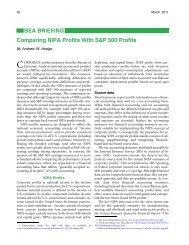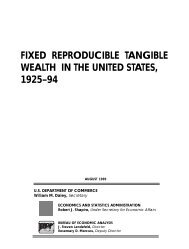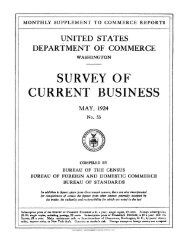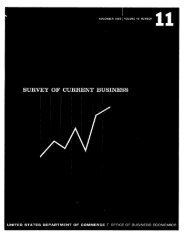current business statistics - Bureau of Economic Analysis
current business statistics - Bureau of Economic Analysis
current business statistics - Bureau of Economic Analysis
Create successful ePaper yourself
Turn your PDF publications into a flip-book with our unique Google optimized e-Paper software.
February 1972 SUEVEY OF CUEEENT BUSINESS<br />
deposits declined slightly from August<br />
to November, showed little change in<br />
December and rose slightly ($% billion)<br />
in January. Given the relatively<br />
strong expansion <strong>of</strong> economic activity<br />
in the closing quarter <strong>of</strong> last year and<br />
the accommodative posture <strong>of</strong> credit<br />
policy, the reasons for the very slugguish<br />
behavior <strong>of</strong> demand deposits are<br />
not at all clear. However, it seems<br />
highly probable that the growth<br />
<strong>of</strong> private demand deposits will<br />
accelerate in the very near future.<br />
The banks are amply supplied with reserves<br />
and credit is readily available,<br />
<strong>business</strong> activity appears to be on the<br />
rise, and the Treasury will be running<br />
down its cash balances.<br />
National Accounts in the Fourth Quarter<br />
On the basis <strong>of</strong> more complete source<br />
data, BEA has revised the estimates <strong>of</strong><br />
national income and product for the<br />
fourth quarter <strong>of</strong> 1971. Total GNP for<br />
the quarter was unchanged but the<br />
components <strong>of</strong> GNP were subject to<br />
various revisions that proved to be<br />
<strong>of</strong>fsetting in the aggregate.<br />
Use <strong>of</strong> additional price data that<br />
became available after the preliminary<br />
estimates were made resulted in generally<br />
small changes in the implicit<br />
deflators <strong>of</strong> the major GNP components.<br />
The net result was a small upward<br />
revision <strong>of</strong> the overall deflator and a<br />
small downward revision <strong>of</strong> total GNP<br />
in constant prices. The revised estimates<br />
show the deflator to have risen<br />
1.7 percent at a seasonally adjusted<br />
annual rate and real GNP 5.8 percent.<br />
Estimated investment in producers'<br />
durable equipment, in <strong>current</strong> prices,<br />
was boosted nearly $2 billion in the<br />
revision process and investment in<br />
nonfarm inventories was raised $1<br />
billion. Eevisions in other components<br />
<strong>of</strong> fixed investment, in consumption,<br />
and in government purchases were all<br />
very small. There was a downward<br />
revision <strong>of</strong> exports <strong>of</strong> goods and services<br />
and a rather sizable upward revision <strong>of</strong><br />
imports. The December figures on<br />
merchandise trade, published late in<br />
January, indicated that trade in the<br />
quarter was even weaker than had been<br />
expected—imports were larger and exports<br />
smaller. The revised GNP<br />
estimates show exports <strong>of</strong> goods and<br />
services to have fallen $7% billion<br />
(seasonally adjusted annual rate) in<br />
the fourth quarter and imports to have<br />
fallen $3% billion; the preliminary<br />
estimates showed declines <strong>of</strong> $7 billion<br />
and $5 billion, respectively. The large<br />
fourth quarter declines in both exports<br />
and imports were one facet <strong>of</strong> the distortion<br />
<strong>of</strong> the trade data in the second<br />
half <strong>of</strong> 1971 because <strong>of</strong> actual dock<br />
strikes and shipments in anticipation <strong>of</strong><br />
strikes.<br />
Balance <strong>of</strong> payments<br />
The revised estimates <strong>of</strong> exports and<br />
imports <strong>of</strong> goods and services indicate<br />
that the balance on goods and services<br />
moved from zero in the third quarter<br />
The unemployment rate was 5.9<br />
percent in January, compared with 6.0<br />
percent in December. It thus continued<br />
to run at the level that ha^ prevailed<br />
for the past year or more. The rates<br />
for the major age-sex groups were<br />
aho generally little changed from<br />
December to January, with the adults'<br />
rate down somewhat and the teenagers'<br />
rate up.<br />
With the release <strong>of</strong> the January<br />
figures on labor force and employment,<br />
the <strong>Bureau</strong> <strong>of</strong> Labor Statistics published<br />
the regular annual revision <strong>of</strong> the<br />
seasonal adjustment factors reflecting<br />
incorporation <strong>of</strong> one more year <strong>of</strong> data<br />
into the calculation <strong>of</strong> the factors. As<br />
is typical, the updating <strong>of</strong> the seasonal<br />
factors had little impact on the patterns<br />
shown by the data. The overall unemployment<br />
rate for 6 months <strong>of</strong> 1971<br />
was unaffected; the revision was only<br />
Employment and Income in January<br />
to a $4% billion deficit (annual rate)<br />
in the fourth. Sufficient data are not yet<br />
available to calculate the full ^pectrum<br />
<strong>of</strong> measures <strong>of</strong> the U.S. external position<br />
in the fourth quarter; estimates <strong>of</strong> the<br />
balance on <strong>current</strong> account and the<br />
balance on <strong>current</strong> account and longterm<br />
capital will not be published until<br />
mid-March. The available data do indicate<br />
that the net liquidity balance and<br />
the balance on <strong>of</strong>ficial reserve transactions<br />
both improved in the fourth<br />
quarter (i.e., the deficits shrank). This<br />
occurred because identified capital flows<br />
and transactions for which fourth<br />
quarter data are available showed sharp<br />
favorable shifts which outweighed the<br />
unfavorable shift in the balance on<br />
goods and services. However, the deficits<br />
were still very large. The net liquidity<br />
balance was in deficit by $4.5 billion<br />
(seasonally adjusted, not at an annual<br />
rate), compared with $9.3 billion in the<br />
third quarter. The <strong>of</strong>ficial reserve transactions<br />
balance was in deficit by $6.1<br />
billion, compared with $12.2 billion in<br />
the third quarter. Details and analysis<br />
<strong>of</strong> the fourth quarter balance <strong>of</strong> payments<br />
will appear in the March SURVEY.<br />
0.1 percentage point in 5 months <strong>of</strong><br />
the year and 0.2 percentage point in<br />
only one month (June, a month that<br />
had shown an unsually sharp decline<br />
<strong>of</strong> 0.6 percentage point to a relatively<br />
low rate <strong>of</strong> 5.6 percent). The revised<br />
data still show a strong rise in employment<br />
and the labor force in the second<br />
half <strong>of</strong> 1971.<br />
The January labor force estimates are<br />
also affected by an adjustment <strong>of</strong> the<br />
population survey on which they rest to<br />
population controls derived from the<br />
1970 Census. This is a one-time upward<br />
adjustment in population, labor force,<br />
and the labor force components (employed,<br />
unemployed). The January estimates<br />
<strong>of</strong> labor force, employment, and<br />
unemployment were all raised by about<br />
the same percentage over estimates<br />
based on 1960-based population controls;<br />
therefore, the overall unemploy-







